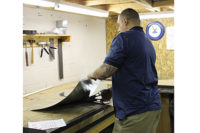The usual stereotype for a millennial is a hip 20-something who lives in the city, rides the subway to work, and rents a chic apartment near bars and restaurants. This image is being turned on its head, thanks to a recent report by the National Association of Home Builders (NAHB), which found that 75 percent of millennials want to live in single-family homes and 66 percent would prefer to live in the suburbs.
Even better news for the HVAC industry, the survey found that having Energy Star-rated appliances was considered essential for 28 percent of millennials and desirable for 60 percent. And, 84 percent of respondents said they would prefer a highly efficient home with lower utility bills and would be willing to pay 2-3 percent more for that privilege.
But, other research conducted by Blackhawk Engagement Solutions insists millennials are price-sensitive, as cost has the greatest influence on their purchase decisions above all other factors, including quality, brand, store, and availability. So, they may not be willing to pay more for the higher efficiency HVAC systems that they claim to want.
PAYING A PREMIUM
Convincing customers to pay more for higher-efficiency systems has been an ongoing challenge for the HVAC industry. This is evidenced by research conducted in 2015 by Emerson Climate Technologies Inc., which showed that, while 56 percent of consumers said they wanted comfort and energy benefits, only 22 percent bought products that actually provided those benefits.
“This means that when faced with the actual purchase, homeowners tend to buy minimum-SEER systems at a lower price versus upgrading to a system that provides enhanced comfort and greater efficiency,” said Sarah Taylor, market manager, communications and planning, air conditioning business, Emerson Climate Technologies.
In this survey, Emerson identified two distinct age groups: those 34 and younger and those 35 and older. When asked about the main reason for purchasing a new HVAC system, the two groups were consistent with many of their answers, said Taylor. “Both were equally interested in things like increasing the energy efficiency of their systems and reducing their energy bills. Both were also likely to replace their current systems, because their previous systems needed too much maintenance and repair or their systems had to be replaced because they simply stopped working and were unrepairable.”
However, when it came to buying a system, the survey showed that younger buyers were almost twice as likely to be concerned about purchase price, but were also much more concerned about premium features, including drafts, clean air, humidity, environmental impact, and having the best technology available. The younger buyers were also almost three times as likely to be concerned about connectivity. “These results suggest younger buyers might be more interested in and informed about premium HVAC features but will be more likely to shop for the lowest-priced systems that can deliver the features they care most about,” said Taylor.
At this point, it is difficult to know whether millennials will be willing to pay a premium for higher-efficiency equipment, because this generation is just now starting to purchase homes.
“While millennials have just broken the surface when it comes to the HVAC industry, they will be the buying power that keeps these products moving over the next three decades, at least,” said, Jeff Preston, product manager, unitary products group, building efficiency, Johnson Controls Inc. “I have no doubt that product value will be paramount in their selection, but features that come at a premium price will not likely appeal to them, because millennials have been saddled with costly events in their life, including student loans and the recession of 2008.”
However, better financing options could encourage millennials to purchase more energy-efficient products, said John Miles, general manager, eco systems, Sanden Intl. (USA) Inc. “Millennials understand the link between efficiency and lower utility bills. A good parallel is the automotive industry, where the smaller and hybrid car segments direct their advertising dollars at the millennial audience. But while almost 100 percent of automotive purchases are financed, this continues to be a very underserved area of the HVAC market. The HVAC industry still expects a check for the whole amount on completion of the project. I believe the market for energy-efficient products would grow if better financing options were available.”
WHAT THEY WANT
Even though millennials may not yet be willing to pay a premium for high-efficiency products, there is no question that they want those types of systems. According to Emerson’s study, younger homeowners tended to agree with statements about the positive attributes of their systems, such as repair notifications, the ability to monitor and control their home’s climate remotely via the internet, good humidity levels, clean air, and minimal global environmental impact, noted Taylor.
“Millennials seem to be more energy-conscientious and overall more concerned about environmental impacts,” said CJ Corbet, sales engineer, Fujitsu General America Inc. “I think they’re looking for the most energy-efficient and earth-friendly product they can find in an HVAC system, but terms like SEER and AFUE are not as important to millennials as Wi-Fi and automation.”
That’s because the millennial generation is the first to grow up with computers, video games, and even cellular phones, noted Corbet, who happens to be a millennial. “However, a millennial’s money is almost always going to be spent on the more attractive technologies before a Wi-Fi-enabled HVAC system. Turning on your a/c from your car 30 minutes before you get home is a luxury that easily takes a backburner to other technologies. Simply put: Why pay for the integration when you can set a program and walk away?”
Ben Poole, founder of Trusted Heating and Cooling LLC in Austin, Texas, agrees that millennials are interested in HVAC systems that feature the latest technologies. “It’s the technology that draws millennials toward premium systems, not higher energy efficiencies. But, while most say they want premium systems, only a handful are actually willing to spend the money for one. We’ve found that they are more willing to invest in duct-sealing and IAQ products in order to improve comfort and the health of their homes, but they do not necessarily make buying decisions based on efficiency.”
Still, many millennials have yet to purchase a home, so buying an HVAC system is not even on their radars. For those who do purchase homes, it seems unlikely they would pay for premium HVAC systems, especially when they can’t afford them or could use the same money to make upgrades that might make the home more appealing for resale, said Corbet. “For example, I recently met a millennial family whose HVAC system had broken down. They didn’t have the money to pay for a replacement unit, much less a more efficient one, even when they seemed excited that they would save money on their summer cooling expenses. They opted to repair the unit, which was nearing 10 years old, and elected to delay replacing the unit until the last possible moment.”
As millennials start buying and upgrading their homes, there is no question they will make a greater impact on the HVAC industry. Many in the industry hope this generation’s desire for earth-friendly products will eventually lead them to purchase high-efficiency systems. “Ultimately, millennials will drive the HVAC industry to think outside the box and deliver more technologically advanced products that offer greater convenience, comfort, and efficiency,” said Poole.
Publication date: 6/27/2016
Want more HVAC industry news and information? Join The NEWS on Facebook, Twitter, and LinkedIn today!









